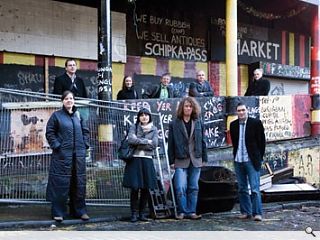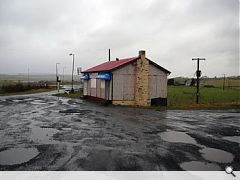Down towns
27 Feb 2009
Glenrothes was named as the most dismal place in Scotland recently in the annual Carbuncle Awards. But this yearÕs jury (pictured) felt that ScotlandÕs towns are struggling in general with standards slipping across the board
JUDGING PROCESSESThe Carbuncle awards encompass a four step process, firstly opening up our website to members of the general public. Any town, or any place can be nominated for any reason.
The second stage is a review of these nominations. A member of the Prospect team visits towns to assess whether the nomination is justified so a short list can be drawn up.
The third stage involves a panel of independent judges visiting the short listed towns. Of the four that they travelled to three were felt to meet the criteria for inclusion in the final list of nominations. Those criteria meant that they had to have real potential Ð perhaps a strong sense of community, great infrastructure, great natural setting or perhaps all three. But despite all that, the places were being blighted by centres that fell well below the standards offered by comparable towns.
Finally we published this short list online, and members of the public were again invited to vote. The results were then given to our jury who used this feedback to inform their final decisions.
previous page: The Judges (back row l-r): Colin McColl: McColl Architects, Esther Weir: CRGP, Neil de Prez: 3D Reid, Gordon Duffy: Studio DuB, Willie Miller: Willlie Miller Urban Design. Front row l-r: Karen Moir: RMJM, Chantelle Nblock: PHD student Glasgow School of Art, John Glenday: Prospect, Gordon Young: Prospect
GLENROTHES
Amidst great fanfare and chaotic scenes Glenrothes brushed aside strong competition from New Cumnock and Motherwell to be crowned Carbuncle king 2009. Bemused locals looked on in wonder as the media cavalcade rode into town, providing Glenrothes with its greatest publicity since the recent by-election. Unperturbed by over zealous security who were themselves overwhelmed by the thronging press, ScotlandÕs most famous plook was proudly held aloft for the town to see in all its radiant play-dough glory.
Mindful of press criticism of the Carbuncles in past years Prospect has adopted a changed tone this time around as Gordon Young, editor of Prospect magazine explained: ÒA primary criteria of the Carbuncles is that the towns shortlisted must have real potential, which local leaders for one reason or another are failing to exploit.
ÒWe are not interested in simply criticising deprived areas which are dismal through no fault of their own. We believe the truly depressing places are the ones which could be great, but are stifled by a lack of imagination, creativity and passion.Ó
And to underline how Glenrothes could be great Prospect plans a major conference this Spring, where planners and architects will suggest a way forward for the town, as well as discussing the challenges facing ScotlandÕs urban centres in general.
Appropriately the event will take place in Glenrothes itself and it is being supported by many in the local community including the Glenrothes Futures Group and the Glenrothes Gazette.
For nine years now the Carbuncles have explored ScotlandÕs grimmest nooks and bleakest crannies, putting the drab in the limelight.
They recognise the very worst in town mismanagement, from dismal decay and poor planning to economic ills. Naturally such candor does not sit well with all, provoking some to defend their home turf from outside criticism as accusations of ÒsnobberyÓ are leveled at the antagonists. But such places for good or ill define many of our suburban and rural communities; their story must be told if there is to be any hope of addressing endemic ills.
Our panel were unanimous in their selection of Glenrothes, a sign perhaps of the extent of its fall from the heady heights of sixties optimism. For all its faults however Glenrothes is not without hope for the future, locals are committed and passionate, possessing the grit and determination necessary to push through much needed investment. Prospect hopes that the energies and passion generated by the Carbuncles Award and subsequent conference, can be harnessed in the realisation of residents broader aims.
Glenrothes exhibits a disdain for the beauteous to almost masochistic degrees. Seemingly constructed entirely from shades of grey it presents a dispiriting backdrop for shoppers huddling from their cars to the hermetically sealed confines of the Kingdom Centre. The town centre has been critically maimed by many ill advised sixties planning decisions with pedestrian movement coming second to the motor car.
Perhaps GlenrothesÕ most egregious error is in turning its shopping experience inside out. In the fashion of New Town planning prevalent at the time all stores turn their backs to the street to front an internalised mall experience that entirely replaced the traditional High Street.
Many have commended the interior environment of plastic furniture, yellow artificial light and softly pumped lift music as a pleasant enough shopping experience. A diverse range of stores were in evidence although locals did complain of a lack of higher end provision, certainly the corridors of consumption were thronged with crowds of bargain hunters, perhaps sheltering from the worst a mid winter climate could throw at them.
Our judges remarked: ÒThere is money here but the main arrivals space, a bus station, is depressing. If the shopping spine extended to some kind of public realm turning the centre inside out then some form of townscape might develop around that. At the moment there is no interaction between this and some kind of historic grasp of the land, no New Towns do that. They werenÕt designed to do anything else.
ÒCan we call this a town centre? It all closes at night which is useless. Half of these shops could close in the next 12 months, itÕs an appalling risk for a town centre to be entirely retail based, itÕs not flexible for other use.Ó
Said Young: ÒThe present economic malaise weighs heavily on us all, the sight of so many boarded up shops a depressing sign of the age. Current difficulties however do not excuse mismanagement; rather they represent an engine for change. The economic model of our recent past has failed. Through conspicuous consumption in ever multiplying out of town malls, car dependence and a disregard for beauty we have saddled ourselves with a bedraggled phalanx of forlorn settlements. Rather than use the present situation to excuse second best or manage decline we should embrace the power of the Carbuncles to galvanise community support, a true catalyst for change.
ÒA time of economic slow-down is an ideal opportunity to have this debate. The frenetic development of the last few years has paused, giving us an opportunity to take stock and ask searching questions about what has been achieved. Real reflection now will stand us in good stead for when the economy recovers.Ó
He added: ÒThe Plook on the Plinth is not meant to be tongue in cheek. It is meant to be controversial and it is meant to catapult some of the issues closest to our hearts into the mainstream press. And we believe getting this issue into the public domain is vital as far as our small towns are concerned.
ÒArchitects and planners are not solely responsible for the problems. The truth is we all are Ð local authorities who neglect their duties, developers who throw up rubbish, builders who use sub-standard materials, retailers who do not invest in their estates and the public who have simply accepted this state of affairs.
ÒWe hope the Carbuncles will provide a mechanism for saying enough is enough and provide those demanding change with some powerful ammunition.Ó
Perennial favourite Cumbernauld and its Lanarkshire brethren breathed a collective sigh of relief this time around as it was decided that no prior winner of the award was eligible for nomination. This is not necessarily an indication of substantial improvement but reflective of a desire to include other parts of Scotland.
Young commented: ÒThere does seem to be a real problem with how our towns are developing across the board. And this will be something that we are keen to examine as part of our townsÕ forum, which will take place in Glenrothes this Spring.Ó
Colin McColl, McColl Architects
ÒOn arrival the question must be asked Ð where were me meant to go? Faced with the back ends of shops and a car park there was clearly no sense of civic centre in the traditional sense. However this is a new town and this diagram is clearly different.
ÒThe vibrancy of the internal street within the shopping centre was noticeable but I agreed with other judges that what happens at 5.30 when the shops close? The centre of the town, commercially driven since its inception, is closed down. It was difficult to understand where, if you asked someone from Glenrothes, you would stick a pin in what would be identified as civic heart of the town. This maybe is the flaw with the new town model.
ÒSince the original development there has also been a series of awkward additions around the periphery of the centre, which have unfortunately contributed to the sense of foreboding. These additions have diluted the original diagram of Glenrothes and I believe that with some new ideas and energy that add positively to the Glenrothes model you can create the sense of place, civic spaces and various facilities that all the towns that we viewed were missing in some form or another.
ÒSo the new town model could potentially be reinvigorated to again provide a new town model with many principles having the possibility of being applied to many places across the country. I feel that with some work it would reignite the optimism of the original new town ideals and provide a framework for discussion that could be debated across our entire country.Ó
Willie Miller, urban design consultant
ÒI think more than the other towns, this is a place in search of physical solutions.Ê In a sense it has played true to its origins as a Mark I New Town and doesnÕt seem to have been unpicked to the same extent as Cumbernauld. Reinventing the town centre would certainly be an attractive architectural exercise but may not be the main thing the community aspires to Ð nor may it be economically possible.Ê It is possible that the local community have become used to this arrangement of internalised spaces and Radburn-esque vehicle and pedestrian arrangements Ð I donÕt like it especially the way it is but IÕm not sure that reintroducing streets and open shopping is necessarily the answer.ÊIt wouldnÕt happen at Braehead Ð would it?Ó
MOTHERWELL
Our race for Carbuncle of the year was a close run thing between the vying challengers. Motherwell in particular, though, stuck out for its relinquishing of a successful historic street plan. It was felt that had this been retained the town would have had a much better chance of creating a credible space.
Colin McColl of McColl Architects said: ÒOn arrival in the town centre my first instinct was to ask whether or not we were actually in the centre.
ÒWhere was the sense of a historical grain that had developed incrementally over time and linked together various civic spaces? The townscape had been altered irrevocably by Brutalist and 1980s developments and there was a pervading sense that although the town centre was busy, it was on a precipice. These developments had removed the identity of the town and there was a lack of a sense of place.
ÒFurther, Motherwell did not seem to have any clear strategy for the newer additions that had been built in and around the town centre and as a Plook on the Plinth contender would it benefit the most from a rethink on the strategy. Motherwell seemed to be a downtrodden ÔburbÕ with no personality.Ó
The judges felt that, perhaps, Motherwell had most to gain from the unwanted award. ÒWho needs the biggest kick up the butt?Ó they asked. ÒThereÕs potentially more value in criticising Motherwell, people have read articles on New Towns before.Ó
The intrinsic town centre structure of the place was considered workable and public transport was well catered for by train, unlike Glenrothes which was far more car dependant. The worst bits of Motherwell were considered to be the newest areas, placing the town on a slippery downward trajectory. Our panel were particularly scathing of peripheral development: ÒThese noddy homes amongst sheds on the outskirts are shocking, theyÕre building in things that will restrict them enormously in future.Ó
Willie Miller, an urban design expert, said: ÒThe retail core of the town centre is actually better than I remember it but step out of that and you are in the land of 1960s and 70s planning where ring road and massive car parks go hand in hand.ÊThere isnÕt any way in which this is a cohesive centre integrated with the rest of the town and therein lies the challenge.Ê
ÒThis will become more acute when or if Ravenscraig gets going - in this context, Motherwell town centre could be circling the drain. What is needed is an entirely new approach that seeks out a range of other roles for the centre (civic, educational, cultural, residential) and connects it better to the rest of the town.Ó
NEW CUMNOCK
Our panel actually felt quite sorry for New Cumnock. It was clear that the council had largely abandoned the local populace to their fate. A fact borne out by the demolition of hundreds of houses, few of which were being replaced, and the planned closure of its town hall. New Cumnock is limping through the present with no future to guide it and is slowly reverting back to its pre-industrialised village roots.
This decline need not be catastrophic nor terminal however. Greater use of the towns biggest asset, its station, could be made. The village centre comprises a busy trunk road and this needs to be addressed to enhance the environment. Adopting a linear High Street model, focussed on the station, remains the townÕs best hope for New Cumnock has a High Street. It may be sad but itÕs there.
Containment of this space, improving pedestrian crossings, building a consistent line and providing transport links into the late eveningÉ these should all form the basis of a town framework.
Miller remarked: ÒI think the theme here must inevitably be working with the community to build a more compact settlement probably over many years.ÊThe railway may become increasingly important and the quality of what is left of the main streets needs to be improved by carefully dispensing with late 20th century traffic infrastructure.Ê New Cumnock also needs to find new roles and reasons to exist - other than being a welfare village.Ê It isnÕt really about the architecture but about community, economy and structure.Ó
McColl agreed: ÒOn arrival it was clear that the town had been in a downward spiral for sometime. The closure of local industry had only exacerbated this situation and provided further reason for lack of investment.
ÒIt seemed to me that through no fault of the towns people themselves there was a sense that they had been forgotten.
ÒI do not think it would necessarily take much to help here, with a focus on regenerating the main street and extending the traditional linear model to the station, which at the moment is somewhat separate from the town.
ÒOne suspects that the transport network, in particular the rail links to Glasgow, would need to be considerably improved to make New Cumnock a viable commuter settlement in a stunning location. However, will the investment be made with the town as it is? A catch 22.Ó
One aspect of New Cumnock which did not go unnoted was the warmth and conviction of local residents. Robert Guthrie, a member of the New Cumnock Liaison Group, said: ÒI hope that although New Cumnock has not won the Carbuncle Award that your judges donÕt forget us. ItÕs fantastic, that like a good many of us who feel passionate about our community that you too recognise its potential, although I fear that in your short visit to our village you will not really have appreciated how much more our parish has to offer.
ÒAs a member of one of the local community groups I truly hope that being short listed will encourage the Council to accelerate some of the ideas of regeneration we have been sharing with them. All the depressing photos you have shown in places like the Architecture Scotland forum are of private properties but sadly these are likely to be joined in the not too distant future by our Town Hall, which the Council has declared Ôsurplus to their requirementsÕ.Ó
Unable to resist such a cry for help Prospect has invited a delegation from New Cumnock to attend the Glenrothes conference, it is hoped that with an armoury of viable uses for the building our candidates will be able to tap the Town Centre Regeneration Fund. If ever a town was worthy of such largesse then surely New Cumnock was it, as McColl pointed out: ÒAlthough I think New Cumnock has the most to gain from the award, I did not have the heart to give it to them.Ó
PLAZA
A scheme to convert the former Plaza Ballroom Ð a much loved dance hall where every GlaswegianÕs granny courted it seems Ð has been identified as the worst new building.
The scheme saw the incorporation of the original single story Ballroom faade into an ugly block of flats. But it is overwhelmed by the new edifice which lacks any form of style or design quality.
Said Gordon Young: ÒWhat were these people thinking of? They have ended up with a building that looks ridiculous. More balls up than ballroom.Ó
The Plaza suffers from a range of architectural and quality failings compounded by prominence on an arterial road and excessive massing. In design the development lacks ground level retail instead choosing to present a dead car park toward the busy Victoria Road. Retaining the faade of a historic ballroom which previously occupied the site does not absolve architect or developer of design responsibilities.
Lack of ambition can be read all too clearly in the cheap materials, layered red and buff bricks topped by a lopsided penthouse level, demonstrating, a complete failure on the part of all parties to enforce any semblance of quality control. By not relating to its context, the Plaza is indicative of a lack of respect for the urban realm.
Our judges were keen that the Plaza serve as a warning to others: ÒProjects of this calibre need to be pilloried as a wake up call to others and should not act as a precursor to many more clones. It is symptomatic of a wider malaise in residential design with tick box architecture and a reliance on buy to let skewing longer term principles.Ó
With vociferous backing from the public our team derided what amounted to a purely money making exercise at the expense of place making.
The Glasgow Evening Times asked passers by what they thought of the building:
Brian Kelly, 59 said: It has been built upside down. The dance hall was brilliant, but this is dreadful.Ó
Jaqueline Allan, 43 said: ÒThis is awful, a blot on the landscape.Ó
Gerry Thomson, 38 said: ÒI am amazed that there were architects involved in this design. ItÕs one of the most uninspiring IÕve seen in a long time.Ó
Elaine Gallager, 48 said: ÒItÕs not a very attracive building but it is what I suppose people build these days.Ó
Masoud Faez, 35 said: ÒI really donÕt like it. It has to be one of the ugliest buildings around here. IÕve seen inside and that is dreadful too.Ó
They say every cloud has a silver lining and the current recession was viewed positively by many after some of the duff detritus of the boom years. The only concern is that planners will be reluctant to say no to developments of this ilk as they desperately cling to whatever crumbs are thrown their way.
TRUMP
Donald TrumpÕs controversial golf resort at the Menie Estate, Aberdeenshire, came in for some stick by the Carbuncles group, setting it on course for the worst planning decision trophy on the back of much local ruction. Our panel was concerned that by overriding planning principles and the Site of Special Scientific Interest status a dangerous precedent had been set for future development, calling into question the authority of these measures. Concerns were also raised that the golf resort was effectively a front to usher in a giant housing scheme via the back door.
TrumpÕs hole in one arose after the project was originally rejected by councillors only to be overturned by the Scottish Government. Council planner Martin Ford was sacked in the ensuing fallout after using his casting vote to block the plans.
Despite ecological concerns over the loss of natural coastline habitat, proponents of the venture cite the strong business case of jobs, tourism and investment helping to diversify the local economic base with environmental worries being par for the course in a scheme of this magnitude.
Opponents had castigated the ÒBrigadoonÓ Scotch vernacular of the main hotel block seen on initial sketch designs from American practice Wimberly Allison Tong & Goo, regarding them as shifty as the dunes they sat on by all and sundry. Responding to this criticism Trump opted to commission Scottish architectures man of the moment, Gareth Hoskins, to design the notorious resort.
Much now rests on the ability of Hoskins to hold his ground and insist upon a high calibre of design. Hoskins has stated that he has held ÒfrankÓ discussions with the pugnacious New Yorker and would not allow himself to become tarnished by association with tasteless exuberance, choosing instead to work with the landscape and create a sustainable community.
Thus far TrumpÕs officials are adhering to this script, in public at least, but it remains to be seen if Hoskins can contain the nouveau riche excess of AmericaÕs most famous Scotsman.
Our panel remarked ÒHe (Trump) is providing a solution to a problem that doesnÕt exist in the first place.Ó Economic salvation was also called into question with doubts raised about the employment of local people in the project - Aberdeen has one of the lowest unemployment rates in the country.
Nevertheless the investment proffered, even if somewhat less than the full billion dollar bonanza, is evidently an alluring prospect, particularly in the current climate. Trump does not quite win a free reign to do as he pleases, a cap of 500 homes has been apportioned to the developer and protection of sand dunes and wildlife has been stipulated.
|
|
Read next: Falkirk's stallion display
Read previous: Shine a light
Back to February 2009
Browse Features Archive
Search
News
For more news from the industry visit our News section.
Features & Reports
For more information from the industry visit our Features & Reports section.











